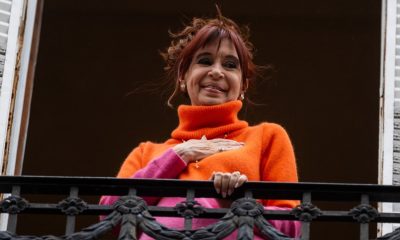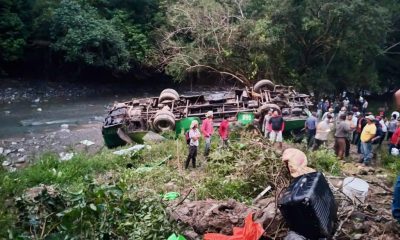International
NASA spaceship deflected asteroid in test to save Earth

AFP / Issam Ahmed
NASA on Tuesday said it had succeeded in deflecting an asteroid in a historic test of humanity’s ability to stop an incoming cosmic object from devastating life on Earth.
The fridge-sized Double Asteroid Redirection Test (DART) impactor deliberately smashed into the moonlet asteroid Dimorphos on September 26, pushing it into a smaller, faster orbit around its big brother Didymos, said NASA chief Bill Nelson.
“DART shortened the 11 hour 55 minute orbit to 11 hours and 23 minutes,” he said. Speeding up Dimorphos’ orbital period by 32 minutes exceeded NASA’s own expectation of 10 minutes.
“We showed the world that NASA is serious as a defender of this planet,” added Nelson.
The asteroid pair loop together around our Sun every 2.1 years, and pose no threat to our planet.
But they are ideal for studying the “kinetic impact” method of planetary defense, in case an actual approaching object is ever detected.
DART’s success as a proof-of-concept has made a reality of science fiction — notably in films such as “Armageddon” and “Don’t Look Up.”
Astronomers rejoiced in stunning images of matter spreading out thousands of miles in the wake of the impact — pictures collected by Earth and space telescopes, as well as a mini satellite that had traveled to the zone with DART.
Pseudo-comet
Thanks to its temporary new tail, Dimorphos, which is 530-foot (160-meter) in diameter or roughly the size of a big Egyptian pyramid, has turned into a manmade comet.
But quantifying just how well the test worked required an analysis of light patterns from ground telescopes, which took a few weeks to become apparent.
The binary asteroid system, which was around 6.8 million miles (11 million kilometers) from Earth at impact, is visible only as a single dot from the ground.
Ahead of the test, NASA scientists said the results of the experiment would reveal whether the asteroid is a solid rock, or more like a “rubbish pile” of boulders bound by mutual gravity.
If an asteroid is more solid, the momentum imparted by a spaceship will be limited. But if it is “fluffy” and significant mass is pushed at high velocity in the opposite direction to impact, there will be an additional boost.
Never actually photographed before, Dimorphos appeared as a speck of light around an hour before impact.
Its egg-like shape and craggy, boulder-dotted surface finally came into clear view in the last few moments, as DART raced toward it at roughly 14,500 miles (23,500 kilometers) per hour.
Mass extinction
Very few of the billions of asteroids and comets in our solar system are considered potentially hazardous to our planet, and none are expected in the next hundred years or so.
But wait long enough, and it will happen.
The geological record shows, for example, that a six-mile wide asteroid struck Earth 66 million years ago, plunging the world into a long winter that led to the mass extinction of the dinosaurs along with 75 percent of all species.
An asteroid the size of Dimorphos, by contrast, would only cause a regional impact, such as devastating a city.
Kinetic impact with a spaceship is just one way to defend the planet, albeit the only method possible with current technology.
Should an approaching object be detected early, a spaceship could be sent to fly alongside it for long enough to divert its path via using the ship’s gravitational pull, creating a so-called gravity tractor.
Another option would be launching nuclear explosives to redirect or destroy an asteroid.
NASA believes the best way to deploy such weapons would be at a distance, to impart force without blowing the asteroid to smithereens, which could further imperil Earth.
International
At Least Eight Dead and 19 Injured in Deadly Bus Crash in Veracruz, Mexico

A tragic bus accident in the eastern state of Veracruz left at least eight people dead and 19 others injured on Wednesday afternoon, according to local authorities.
The vehicle was traveling through the town of Zontecomatlán when it crashed near a ravine, state Civil Protection officials reported late Wednesday night. “Regrettably, the prosecutor’s office has confirmed eight fatalities,” the agency stated in an official release.
Emergency Response and Medical Care Rescue teams worked into the night to assist the survivors. The 19 injured passengers were stabilized at the scene before being transported to hospitals in the nearby municipalities of Chicontepec and Huayacocotla. While the identities of the victims have not yet been released, Mexican press reports indicate the bus was en route from Mexico City to Chicontepec.
A Recurring Issue on Mexican Highways Road accidents involving long-haul passenger buses and freight transport are a frequent occurrence in Mexico. Experts often cite excessive speed, mechanical failure, or driver fatigue as the primary catalysts for these tragedies.
This latest incident follows another major disaster in late November, where 10 people were killed and 20 injured in a similar bus crash in the western state of Michoacán. The recurring nature of these accidents continues to spark national debate regarding the enforcement of stricter safety regulations for commercial transport units.
International
Jair Bolsonaro Hospitalized for Inguinal Hernia Surgery While Serving Sentence for Attempted Coup

Former Brazilian President Jair Bolsonaro, currently serving a 27-year prison sentence for an attempted coup, underwent surgery this Thursday for an inguinal hernia. The procedure took place at the DF Star Hospital in Brasilia, according to his wife, Michelle Bolsonaro.
The 70-year-old former leader left prison on Wednesday for the first time since his incarceration in late November to prepare for the operation. “My love has just gone to the surgical center,” Michelle Bolsonaro posted on Instagram, where she has been documenting her accompaniment during his hospitalization.
Surgical Expectations and Health History Medical professionals treating the far-right ex-president (2019-2022) anticipate the operation will last approximately four hours. His recovery period in the hospital is expected to extend between five and seven days.
Dr. Claudio Birolini explained on Wednesday that while the surgery is standardized, it remains complex due to the patient’s history. Bolsonaro continues to suffer from the long-term effects of a 2018 campaign rally stabbing, an injury that required several major abdominal surgeries in the years following the attack.
“There is no such thing as a simple surgery. However, this is a scheduled and standardized procedure, so we expect it to be carried out without major complications,” Dr. Birolini stated.
Potential Additional Procedures Following the hernia repair, the medical team will evaluate whether Bolsonaro can undergo a second procedure: an anesthetic block of the phrenic nerve. This nerve controls the diaphragm, and the intervention would aim to resolve a chronic case of recurrent hiccups that has plagued the former president for years.
Bolsonaro remains under heavy security at the medical facility as he serves his lengthy sentence related to the events surrounding the January 2023 institutional crisis in Brazil.
International
Trump Orders Construction of New ‘Golden Fleet’ to Revitalize U.S. Naval Superiority

President Donald Trump issued an executive order this Monday for the immediate construction of two new warships that will bear his name. These vessels will be the pioneers of what he described as the “Golden Fleet,” a future generation of “Trump-class” battleships that he claimed would be “100 times more powerful” than those currently in service.
The announcement took place at his private residence in Mar-a-Lago, Florida. The President indicated that following the initial two ships, the administration aims to commission up to 25 additional vessels. He is scheduled to meet with Florida-based contractors next week to expedite production, criticizing existing defense firms for failing to deliver results efficiently.
This naval expansion is a cornerstone of Trump’s goal to revitalized the American shipbuilding industry and address the strategic gap between the U.S. and competitors like China.
The move comes amid heightened geopolitical tension. Just last week, Trump ordered the seizure of all sanctioned tankers involved with Venezuela’s “ghost fleet” to cripple the country’s crude oil industry. Since December 10, the U.S. military—deployed in the Caribbean under the guise of counter-narcotics operations—has already detained two tankers linked to Venezuelan oil transport.
-

 International3 days ago
International3 days agoU.S. Judge Blocks ICE from Re-detaining Salvadoran Erroneously Deported Under Trump Administration
-

 International4 days ago
International4 days agoCristina Kirchner recovering after appendicitis surgery in Buenos Aires
-

 International3 hours ago
International3 hours agoAt Least Eight Dead and 19 Injured in Deadly Bus Crash in Veracruz, Mexico
-

 International4 days ago
International4 days agoFire at substation triggers major blackout in San Francisco
-

 International3 days ago
International3 days agoTrump Orders Construction of New ‘Golden Fleet’ to Revitalize U.S. Naval Superiority
-

 International3 hours ago
International3 hours agoJair Bolsonaro Hospitalized for Inguinal Hernia Surgery While Serving Sentence for Attempted Coup






























